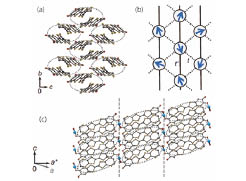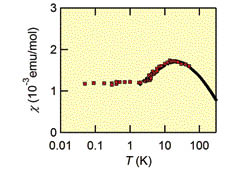Gapless Quantum Spin Liquid State in a Purely Organic Spin-1/2 Triangular Lattice κ-H3(Cat-EDT-TTF)2
Mori Group
A quantum spin-liquid (QSL) state is an exotic ground state where interacting spins continue to fluctuate without any formation of long-range magnetic order (LRMO) even at a sufficiently low temperature. A variety of QSL states have been theoretically predicted, but nevertheless, a systematic understanding of the elementary excitation from the experiments remains an arduous challenge. This is mainly because of the rareness of the experimental candidates, which are still restricted to the several spin-frustrated lattices, such as triangular, kagome, and hyperkagome lattices. Recently, Mori group has discovered gapless quantum spin liquid state in a purely organic spin-1/2 triangular lattice κ-H3(Cat-EDT-TTF)2 (abbreviated as κ-H)[1,2]. In this article, the results of SQUID and torque magnetometry suggesting the QSL state with gapless magnetic excitations in purely organic single-component molecular Mott insulator, κ-H, have been demonstrated [3].

Fig. 1. (a) Molecular arrangement in a two-dimensional layer (b-c plane) of κ-H3(Cat-EDT-TTF)2. The dotted ellipsoids denote the strongly dimerized molecules. (b) A schematic of the anisotropic triangular lattice with transfer integrals t’ and t. The closed circles and the arrows on them represent the sites of the triangular lattice composed of the dimerized molecules and the S = 1/2 spins, respectively. (c) The interlayer packing structure viewed in the a-c plane. The adjacent layers are connected by hydrogen bonds. The dotted ellipsoids represent dimerized molecules similar to those described in (a).

Fig. 2. Magnetic susceptibility as a function of temperature χ(T) on a semilogarithmic plot. The black diamonds denote the result of the SQUID measurement at 1 T. The red squares represent χ(T) estimated from the torque at 10 T for a–b rotation. The susceptibility χ(T) for the a–b rotation is normalized to χ(50 K) from the SQUID measurement. The χ(T) is nearly independent of temperature below T ~ 3 K, possibly being attributed to the Pauli paramagnetic contribution and suggesting the presence of gapless magnetic excitations in the QSL state.
Samples were prepared by the electrochemical oxidation of H2Cat-EDT-TTF molecules in the presence of a base [1, 2]. A characteristic structural feature of this material is that, in a 2D layer, two face-to-face (H2Cat-EDT-TTF)0.5+ molecules form a strongly dimerized molecular unit, as shown in Fig. 1(a). Because of the strong dimerization, a dimerized unit can be treated as one site, resulting in an effective spin 1/2 per site. As schematically illustrated in Fig. 1(b), each spin is arranged on the triangular mesh with the anisotropy parameter t’/t ~ 1.48 at T = 50 K, where t and t’ are the hopping integrals around the sides of rhomboids and along one diagonal, respectively. It is specific that this Mott insulator contains only conducting layers linked by hydrogen bonds without anion layers (Fig. 1(c)), namely purely organic single-component quantum spin liquid crystal.
Firstly, we measured the static magnetic susceptibility at 1 T employing a magnetic property measurement system (Quantum Design) in the temperature region from 2 to 300 K using poly-crystalline samples of ~16 mg (Fig. 2). The entire temperature dependence of χ is roughly described by the S = 1/2 Heisenberg antiferromagnetic model of an isotropic triangular lattice, with an antiferromagnetic exchange-coupling constant J/kB ~ 80–100 K. To shed light on the magnetic properties at lower temperatures, we measured the magnetic torque. As the magnetic torque only detects the anisotropic susceptibility in principle, the isotropic contribution from impurity spins is naturally eliminated, providing us with the intrinsic low temperature magnetic properties. For our system, it should be noted that sinusoidal behavior with two-fold periodicity is observed up to H = 17 T and down to T = 50 mK. Moreover, the observed amplitude of the sinusoidal torque curve is precisely proportional to the square of the magnetic field. These observations indicate that the system remains paramagnetic even at T = 50 mK. The above argument about the torque together with the susceptibility χ(T) reveals that spin frustration on the triangular lattice strongly suppresses the formation of long-range antiferromagnetic order even at J/kB / T ~ 103, suggesting the development of the QSL state as the ground state. Secondly, we focus on the excitation spectrum of the QSL state. In Fig. 2, χ(T) from torque magnetometory is normalized using χ determined from the SQUID measurement. What is notable in Fig. 2 is that χ(T) is nearly independent of temperature below T ~ 3 K, possibly being attributed to the Pauli paramagnetic contribution. This suggests the presence of gapless magnetic excitations in the QSL state.
In conclusion, we report the results of SQUID and torque magnetometry of an organic spin-1/2 triangular-lattice κ-H3(Cat-EDT-TTF)2. Despite antiferromagnetic exchange coupling at 80–100 K, we observed no sign of antiferromagnetic order down to 50 mK owing to spin frustration on the triangular lattice. In addition, we found nearly temperature-independent susceptibility below 3 K associated with Pauli paramagnetism. These observations suggest the development of gapless quantum spin liquid as the ground state. On the basis of a comparative discussion, we point out that the gapless quantum spin liquid states in organic systems share a possible mechanism, namely the formation of a band with a Fermi surface possibly attributed to spinons.
References
- [1] H. Kamo, A. Ueda, T. Isono, K. Takahashi, and H. Mori, Tetrahedron Lett. 53, 4385 (2012).
- [2] T. Isono, H. Kamo, A. Ueda, K. Takahashi, A. Nakao, R. Kumai, H. Nakao, K. Kobayashi, Y. Murakami, and H. Mori, Nature Commun. 4, 1344 (2013).
- [3] T. Isono, H. Kamo, A. Ueda, K.Takahashi, M. Kimata, H. Tajima, S. Tsuchiya, T. Terashima, S. Uji, and H. Mori, Phys. Rev. Lett. 112, 177201 (2014).
